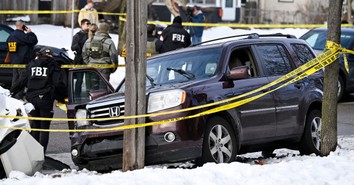"Taking Lives" - Movie Review

Release Date: March 19, 2004
Rating: R (for strong violence, including disturbing images of language and some sexuality)
Genre: Thriller/Drama
Run Time: 103 minutes
Director: D.J. Caruso
Actors: Angelina Jolie, Ethan Hawke, Kiefer Sutherland, Olivier Martinez, Tcheky Karyo, Jean-Hugues Anglade, Gena Rowlands
A serial killer is on the loose in Montreal, and his victims, all Caucasian males who tend to be loners, are increasing in number. The killer’s modus operandi is consistent: bash in their skulls and chop off their hands. It’s a gruesome case that has local authorities perplexed, so FBI profiler Illeana Scott (Angelina Jolie) arrives from Washington to help. Scott has experience with psychotics, so when Kosta (Ethan Hawke) says that he witnessed the killer murdering his latest victim, Scott takes the lead on the case.
Kosta, a local art dealer, claims to have witnessed the killer with his latest victim. He is covered in blood and acting suspicious, but Scott insists that he shows signs of a psychotic personality and is reacting exactly as she would expect for someone who has just witnessed a brutal murder. Despite reservations from a fellow officer (Olivier Martinez), they let him go – after Kosta draws a picture of the alleged murderer. Soon, they realize that the killer is taking on the identities of his victims, one by one – and a stranger who looks like the drawing (Kiefer Sutherland) begins stalking Kosta. So they set up a sting, with Kosta posing as bait. Meanwhile, Scott and Kosta are experiencing some serious synergy. But can Kosta be trusted?
OBJECTIONABLE CONTENT: "Taking Lives" | |
• = Mild •• = Average ••• = Heavy •••• = Extreme | |
Adult Themes: | •••• |
Drugs/Alcohol Content: | ••• |
Language/Profanity: | •••• |
Sexual Content/Nudity: | •••• |
Violence: | •••• |
“Taking Lives” is a creepy movie that fully deserves its R-rating. In the opening scene, an unsuspecting teen viciously attacks another teen, smiling as he murders his victim. Shots of dead bodies are hideously graphic, with missing body parts, bloody torsos and faces that have been mutilated beyond recognition. We see these images again and again, throughout the film, because Scott carries them with her, even sleeping with photos of the victims above her bed. In fact, it’s almost as if director D.J. Caruso is obsessed with bodily mutilation. The final scene of the film consists of an intense fight with strangling and stabbing.
No stranger to nudity, Jolie bears her breasts in one scene then engages in explicit sex reminiscent of “Monster’s Ball,” although her male partner remains clothed (how typical). The dozen or so profanities and obscenities scattered throughout the movie are graphic.
On a cinematic level, “Taking Lives” will keep you on the edge of your seat, with several unexpected twists that maintain the suspense and a couple of “gotchas.” Some will guess the ending, but you’re never really sure until the end. The film is also well-acted, with excellent performances from Jolie, Hawke, Martinez, Sutherland and Jean-Hugues Anglade, as the chief of police. Although the characters remain largely undeveloped – typical for this genre – what roles they do have, the actors perform well. It’s also a relief to see the quaint city of Montreal as a setting and native French-speaking actors, rather than Americans trying to imitate a French accent. Too bad we don’t see more of both.
Those looking for strong role models for women will appreciate a woman as the main character – and a cop, a role that is almost always assigned to male actors. Unfortunately, however, although Agent Scott is brilliant, she allows loneliness to cloud her judgment in a near-fatal choice that places the investigation in peril, frees a dangerous killer and ruins her career. She redeems herself, but not without great loss, including more murders. So ultimately, her character’s moral failures negate any positive attributes she may have possessed as a potential role model.
One must also question the motivation (apart from the obvious financial gain) of filmmakers who choose to focus on the psychosis of serial murder, creating a graphic, gruesome film. With its inherent suspense-filled stalking of the murder victims, the psychological thriller perpetuates tremendous fear in audiences – something we already experience with alarming regularity with the daily news. The genre, and particularly this film, also leaves the viewer with the lingering concern that murdering psychotics are out there, waiting to prey upon us, even as they elude capture by the best and the brightest law enforcement officers. This is not a reassuring thought.
It’s obvious that “Taking Lives” is not for kids. But even adults must ask themselves whether these images of fear and death should be given access to roam our hearts and minds.
Originally published March 19, 2004.







